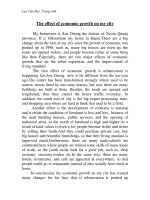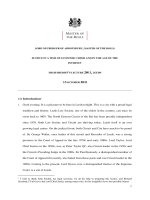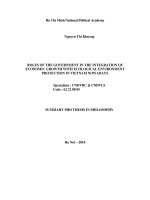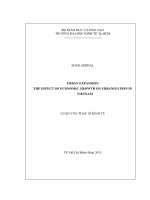Puzzles of economic growth (directions in development)
Bạn đang xem bản rút gọn của tài liệu. Xem và tải ngay bản đầy đủ của tài liệu tại đây (6.32 MB, 355 trang )
Public Disclosure Authorized
Public Disclosure Authorized
92864
Public Disclosure Authorized
Public Disclosure Authorized
DIREC TIONS IN DE VELOPMENT
Public Sector Governance
Puzzles of Economic Growth
Leszek Balcerowicz and Andrzej Rzońca, Editors
Puzzles of Economic Growth
Direc tions in De velopment
Public Sector Governance
Puzzles of Economic Growth
Leszek Balcerowicz and Andrzej Rzońca, Editors
© 2015 International Bank for Reconstruction and Development / The World Bank
1818 H Street NW, Washington DC 20433
Telephone: 202-473-1000; Internet: www.worldbank.org
Some rights reserved
1 2 3 4 17 16 15 14
This work is a product of the staff of The World Bank with external contributions. The findings, interpretations, and conclusions expressed in this work do not necessarily reflect the views of The World Bank, its
Board of Executive Directors, or the governments they represent. The World Bank does not guarantee the
accuracy of the data included in this work. The boundaries, colors, denominations, and other information
shown on any map in this work do not imply any judgment on the part of The World Bank concerning the
legal status of any territory or the endorsement or acceptance of such boundaries.
Nothing herein shall constitute or be considered to be a limitation upon or waiver of the privileges and
immunities of The World Bank, all of which are specifically reserved.
Rights and Permissions
This work is available under the Creative Commons Attribution 3.0 IGO license (CC BY 3.0 IGO) http://
creativecommons.org/licenses/by/3.0/igo. Under the Creative Commons Attribution license, you are free to
copy, distribute, transmit, and adapt this work, including for commercial purposes, under the following
conditions:
Attribution—Please cite the work as follows: Balcerowicz, Leszek, and Andrzej Rzon´ca, eds. 2015.
Puzzles of Economic Growth. Directions in Development. Washington, DC: World Bank.
doi:10.1596/978-1-4648-0325-3. License: Creative Commons Attribution CC BY 3.0 IGO
Translations—If you create a translation of this work, please add the following disclaimer along with the
attribution: This translation was not created by The World Bank and should not be considered an official
World Bank translation. The World Bank shall not be liable for any content or error in this translation.
Adaptations—If you create an adaptation of this work, please add the following disclaimer along with the
attribution: This is an adaptation of an original work by The World Bank. Responsibility for the views and
opinions expressed in the adaptation rests solely with the author or authors of the adaptation and are not
endorsed by The World Bank.
Third-party content—The World Bank does not necessarily own each component of the content contained
within the work. The World Bank therefore does not warrant that the use of any third-party-owned
individual component or part contained in the work will not infringe on the rights of those third
parties. The risk of claims resulting from such infringement rests solely with you. If you wish to
re-use a component of the work, it is your responsibility to determine whether permission is needed
for that re-use and to obtain permission from the copyright owner. Examples of components can
include, but are not limited to, tables, figures, or images.
All queries on rights and licenses should be addressed to the Publishing and Knowledge Division, The
World Bank, 1818 H Street NW, Washington, DC 20433, USA; fax: 202-522-2625; e-mail: pubrights@
worldbank.org.
ISBN (paper): 978-1-4648-0325-3
ISBN (electronic): 978-1-4648-0326-0
DOI: 10.1596/978-1-4648-0325-3
Cover image: © Grzegorz Pabel/World Bank Art Program. Further permission required for reuse.
Cover design: Debra Naylor, Naylor Design, Inc.
Library of Congress Cataloging-in-Publication Data has been requested.
Puzzles of Economic Growth • />
Contents
Prefacexv
Abbreviationsxix
Chapter 1
The Significance of Economic Growth
Leszek Balcerowicz and Andrzej Rzon´ca
1
Long-Term Growth
2
Shocks and Periods of Relatively Stable Growth
3
A Brief History of Economic Research
4
Research Methods Applied in This Volume
16
Conceptual and Analytical Framework
18
Notes24
Bibliography28
Chapter 2
Institutional Systems and Economic Growth
Leszek Balcerowicz and Andrzej Rzon´ca
37
Innovation-Based Growth and Special Growth Mechanisms 38
Determinants of Individual Choice
41
Institutional Systems and Individual Decisions
42
Information Barriers to Innovation-Based Economic Growth 46
Institutional Barriers
47
Cases of Accelerated Economic Growth
57
Successful Reform Packages
60
Summary72
Notes74
Bibliography85
Chapter 3
How Did Australia Get Ahead of New Zealand?
Jakub Szeliga
91
Differences in Economic Performance: Factors and Causes 93
Summary and Conclusions
101
Notes103
Bibliography103
Puzzles of Economic Growth •
v
vi
Contents
Chapter 4
How Did Austria (Nearly) Catch Up with Switzerland?
Marcin Hołda
105
Differences in Economic Performance: Factors and Causes 110
Summary and Conclusions
125
Notes126
Bibliography128
Websites131
Chapter 5
Why Did the Economic Growth Paths of Estonia
and Slovenia Diverge?
Paweł Cwalina
133
Differences in Economic Performance: Factors and Causes 137
Summary and Conclusions
149
Notes150
Bibliography153
Websites156
Chapter 6
Why Is Mexico Poorer Than Spain?
Anna Kurowska
157
Differences in Economic Performance: Factors and Causes 159
Summary and Conclusions
171
Notes172
Bibliography174
Chapter 7
Why Has República Bolivariana de Venezuela’s Economy
Stagnated and Chile’s Flourished?
177
Agnieszka Łyniewska
Differences in Economic Performance: Factors and Causes 180
Summary and Conclusions
195
Notes197
Bibliography199
Chapter 8
Why Is Costa Rica Lagging Behind Puerto Rico?
Kamil Czop
201
Differences in Economic Performance: Factors and Causes 205
Summary and Conclusions
225
Notes227
Bibliography228
Chapter 9
Why Is Haiti Poorer Than the Dominican Republic?
Aleksander Łaszek
231
The Pace of Economic Growth
231
Differences in Economic Performance: Factors and Causes 235
Puzzles of Economic Growth • />
vii
Contents
Political Stability, Internal Security, and Property Rights
243
Openness246
Inflow of Foreign Funds
248
Summary and Conclusions
252
Notes253
Bibliography256
Chapter 10
How Has China Outpaced India?
Paweł Kozub
259
Differences in Economic Performance: Factors and Causes 263
284
Summary and Conclusions
Notes286
Bibliography287
Chapter 11
Why Has Pakistan Developed More Slowly
Than Indonesia?
Filip Berkowski
291
Differences in Economic Performance: Factors and Causes 294
Summary and Conclusions
308
Notes311
Bibliography312
Chapter 12
Conclusions
Leszek Balcerowicz and Andrzej Rzon´ca
315
Notes331
Boxes
6.1
9.1
9.2
Speculative Attacks on the Peso in 1993–94 Preceding
Devaluation: Political Context
The Contribution of Investment to GDP in Haiti
Remittances from Abroad and Investment
167
236
250
Figures
1.1
2.1
2.2
2.3
2.4
3.1
3.2
Determinants of Short-Term Growth
19
Institutional Systems That Block Economic Growth
48
Reforms and Paths of Economic Growth
64
Changes in the Economic Growth Rate in Time Resulting
from Restricted Reforms
70
Changes in the Rate of Economic Growth Influenced by
Comprehensive Reforms
71
Average Annual Per Capita GDP: Australia and New Zealand,
1946–200292
GDP Per Capita: Australia and New Zealand, 1970–2002
92
Puzzles of Economic Growth •
viii
Contents
3.3
3.4
3.5
3.6
4.1
4.2
4.3
4.4
4.5
4.6
4.7
4.8
5.1
5.2
5.3
5.4
5.5
5.6
5.7
5.8
6.1
6.2
6.3
6.4
6.5
6.6
Government Expenditure in Australia and New Zealand,
1970–200297
Tax Revenues in Australia and New Zealand, 1970–2002
98
General Government Sector Deficit in Australia and
New Zealand, 1970–2002
98
Average Annual Change in the GDP Deflator in Australia and
New Zealand, 1970–2002
100
GDP Per Capita in Austria and Switzerland, 1950–2003
106
Growth Rate as a Percentage of Per Capita GDP: Austria
and Switzerland (International $ in 2000 Constant Prices),
1971–2003107
Developing Countries’ Share of Austria’s and Switzerland’s
111
Total Exports, 1971–2003
The Real Effective Exchange Rate (2000 = 100) of the
Austrian Currency and the Swiss Franc
112
Public Debt, 1990–2003
115
Primary Government Balance, 1991–2003
116
Inflation: Austria and Switzerland Consumer Price Index,
1971–2003117
The Timing of Reforms in the Energy, Transport,
and Communication Sectors: Austria and Switzerland,
1975–2003120
Estimated GDP Per Capita in Slovenia and Estonia, 1971–2007 134
Aggregate FDI-to-GDP Ratio, Estonia and Slovenia, 1990–2004 136
Imports-to-GDP Ratio, Estonia and Slovenia, 1992–2004
137
Index of the Value Added by Industry: Slovenia and Estonia,
1990–2004138
Index of the Value Added by Agriculture: Four Once-Socialist
138
Republics in Transition, 1990–2004
Basic Indicators of Labor Market Flows in Selected Countries
144
The Share of Fixed-Time Contracts in Total Employment
144
Contracts: Slovenia and Estonia, 1989–98
The Value of the Respective Dimensions of the Fraser Index:
148
Slovenia and Estonia in 1995, 2000, and 2004
Differential in GDP Per Capita between Mexico and Spain,
1960–2001158
Index of Economic Openness in Spain and Mexico, 1960–2002 161
Central Government Debt as a Percentage of GDP in Spain
163
and Mexico, 1972–97
GDP Deflator in Mexico and Spain, 1961–2002
163
Current Account Balance as a Percentage of GDP in Spain
166
and Mexico, 1978–2002
Total Net FDI Flows as a Percentage of GDP in Spain and
168
Mexico, 1975–2002
Puzzles of Economic Growth • />
Contents
6.7
Share of the United States, Emerging Countries, and the
European Union in Mexican Exports, 1980–2005
170
7.1
Share of Copper and Crude Oil Exports among Total National
Exports: Chile and República Bolivariana de Venezuela,
1980–2004178
7.2
The Ratio of Copper and Crude Oil Exports to GDP: Chile
and República Bolivariana de Venezuela, 1980–2004
178
7.3
Per Capita GDP: Chile and República Bolivariana de
Venezuela, 1971–2003
179
7.4
Reform Indices of Chile and República Bolivariana de
186
Venezuela, 1971 and 1983
8.1
Annual Average GNP and GDP Per Capita: Puerto Rico
202
and Costa Rica, 1961–2003
8.2
Economy Openness Indicator of Puerto Rico and Costa Rica,
1960–73206
8.3
Public Sector Spending in Puerto Rico and Costa Rica, 1961–73 207
8.4
Inflation Rate in Puerto Rico (U.S. GDP Deflator) and in
208
Costa Rica (CPI), 1960–73
8.5
Share of Federal (U.S. Budget) and Local Social Transfers
213
in Income Per Capita in Puerto Rico, 1965–82
8.6
Public Sector Spending in Puerto Rico and in Costa Rica,
1970–82214
8.7
Inflation Rate in Puerto Rico (U.S. GDP Deflator) and
215
in Costa Rica (CPI), 1972–81
8.8
GDP Per Capita in Selected Latin American Countries,
1960–2003217
8.9
Public Sector Spending in Puerto Rico and Costa Rica, 1980–93 219
8.10
Inflation Rate in Puerto Rico (U.S. GDP Deflator) and
220
Costa Rica (CPI), 1979–92
8.11
Indicator of Economic Openness: Puerto Rico and Costa Rica,
1991–2003221
8.12
Public Sector Spending, Puerto Rico and Costa Rica, 1991–2003 222
8.13
Public Debt of Puerto Rico and Costa Rica, 1991–2003
222
9.1
Per Capita GDP: Haiti and the Dominican Republic in GK$,
1950–2000232
9.2
Per Capita GDP Growth in the Dominican Republic and
Haiti, 1951–2003
233
9.3
Trend in Per Capita GDP, 1951–2001
234
B9.1.1 Share of Investment in GDP according to Different Databases 236
9.4
Contributions to Per Capita Growth: Haiti and the Dominican
237
Republic, 1961–90
9.5
Investment in Absolute Terms and as a Share of GDP,
1960–2000240
9.6
Investment Outlays: Sanity Check, 1950–2000
240
Puzzles of Economic Growth •
ix
x
Contents
9.7
9.8
9.9
9.10
9.11
9.12
9.13
9.14
9.15
10.1
10.2
10.3
10.4
10.5
10.6
10.7
10.8
10.9
10.10
10.11
10.12
10.13
10.14
10.15
10.16
10.17
10.18
10.19
10.20
10.21
11.1
11.2
11.3
11.4
An Index of the Legal System and Property Rights in Haiti
and the Dominican Republic, 1980–2005
242
Polity IV Index
243
Number of Tourists Visiting Haiti and the Dominican
Republic, 1978–2000
246
Dominican Republic: Exports of Goods and Services, 1993–2005 248
Openness of the Two Economies (Exports + Imports as a
Percentage of GDP), 1950–2000
248
Transfers from Abroad (1970–2010, Cumulated, in Dollars
from 2000)
249
Remittances from Abroad, 1970–2000
251
Official Development Aid, 1970–2010
251
Foreign Direct Investment (FDI)
251
GDP Per Capita: China and India, 1950–2001
260
GDP Growth Per Capita in China and India, 1978–2000
260
The Average Annual Impact of Natural Disasters on the
261
Economy, 1980–2005
Savings, Investments, and Capital Productivity
262
Decomposition of Economic Growth in China and India
263
Contribution of Companies to China’s GDP, Depending
267
on the Form of Enterprise, 1991–2000
The Productivity of Enterprises in India
268
Price Control System in China
269
Energy Losses during Power Distribution to Final Users
271
Foreign Direct Investment in China and India
272
Import Obstacles in China and India
273
History of the Chinese Yuan
275
History of the Indian Rupee
276
Inflation Rate (Year-on-Year Changes in GDP Deflator)
277
Exports and Imports in China and India
278
Expenditure on Road Construction
279
Fiscal Deficit
279
Public Sector Deficit: India and China, 1990–2003
280
Value of Particular Components of the Chinese Financial
281
System, 1994–2004
Real Interest Rates in China and India, 1980–2002
282
Value of Particular Segments of the Financial System in India,
1994–2004283
Average Annual GDP Per Capita in Indonesia and Pakistan,
1960–2004292
GDP Deflator in Indonesia and Pakistan, 1967–78
295
Public Sector Expenditure and Revenue as a Percentage
of GDP in Indonesia, 1987–96
303
Public Sector Expenditure and Receipts as a Percentage
of GDP in Pakistan, 1987–96
304
Puzzles of Economic Growth • />
xi
Contents
11.5
11.6
Main Reasons for Fluctuations in Per Capita GDP Growth
in Indonesia, 1961–2004
Main Reasons for Fluctuations in Per Capita GDP Growth
in Pakistan, 1961–2004
309
309
Tables
3.1
3.2
3.3
3.4
3.5
3.6
4.1
4.2
4.3
4.4
4.5
4.6
4.7
4.8
4.9
4.10
5.1
Average Annual Per Capita GDP Growth: Australia and
New Zealand, 1971–2002
93
Average Annual Per Capita GDP Growth in New Zealand,
93
Excluding Collapses of 1971–74 and 1981–86
Oil Prices Changes and Their Importance for Foreign Trade
94
of Australia and New Zealand, 1971–2002
Rate of Changes to the Terms of Trade: Australia and
94
New Zealand, 1971–2002
Average Annual Real GDP Growth of Australia
and New Zealand’s Main Import and Export Partners,
1971–200296
Selected Fraser Institute Subindices of Economic Freedom
in Australia and New Zealand, 1970–2000 (Index Numbers
96
from 0 to 10)
GDP Per Capita in Seven Small, Developed European Countries
106
as a Percentage of GDP Per Capita in Switzerland
Decomposition of Economic Growth: Austria and Switzerland,
1991–2003109
Contribution to GDP and Average Annual Labor Productivity
Growth: Individual Sectors of the Austrian and Swiss
109
Economies, 1991–2000
Average Yearly Exports Growth: Austria and Switzerland
110
(2000 $), 1971–2003
Major Trade Partners in Austria’s and Switzerland’s Exports,
111
1972 and 1989
A Comparison of Price Levels in Austria and Switzerland,
118
1995 and 2003
Indicators of Product Market Regulation in Austria and
119
Switzerland, 1998 and 2003 (Entire Economy)
Regulation Indicators in the Retail Sector and in Professional
Services (Legal, Accounting, Engineering, and Architectural
Services): Austria, Switzerland, and OECD Average,
1996–2003121
Contribution of Internal and External Demand to GDP
Growth: Austria and Switzerland, 1991–2003
123
A Comparison of Relative Import Price Levels: Austria and
124
Switzerland, 2005
Per Capita GDP Growth in Slovenia and Estonia, 1990–2004 134
Puzzles of Economic Growth •
xii
Contents
5.2
5.3
5.4
5.5
5.6
5.7
5.8
5.9
6.1
6.2
7.1
7.2
7.3
7.4
7.5
7.6
7.7
8.1
8.2
8.3
8.4
8.5
Average Annual Per Capita GDP Growth in Slovenia and
Estonia, 1990–2004
135
Russia’s Share of Total Exports and Imports: Slovenia and
Estonia, 1994–98
135
Contributions to GDP Growth in Slovenia and Estonia,
1995–2004135
Contribution of the Private Sector to GDP: Estonia and
Slovenia, 1995–2004
143
Private Sector Employment Related to Total Employment,
1995–2004143
Public Sector Revenue (Including Social Security Contributions)
in Slovenia and Estonia, 1995–2004
145
Public Expenditure in Slovenia and Estonia, 1995–2004
146
The Impact of Administration on New Enterprise Establishment:
148
A Comparison
GDP Growth Breakdown: Spain and Mexico, 1961–77
159
GDP Growth, Inflation, and Fiscal Deficit in Mexico, 1982–88 165
The Dynamics of GDP Per Capita in Chile and República
Bolivariana de Venezuela, 1971–1983
179
A Growth Analysis: Chile and República Bolivariana de
180
Venezuela, 1984–2003
Importance of the Oil Sector in República Bolivariana de
Venezuela, 1970–99
185
The Number of Procedures and the Time Necessary to Register
a New Company in Chile and República Bolivariana de
189
Venezuela, 1999
Selected Indexes of Economic Freedom in Chile and República
Bolivariana de Venezuela, 1980−2000
190
Distribution of National Income in República Bolivariana de
Venezuela, 1950–98
192
Average Annual Changes in Inflation: Chile and República
194
Bolivariana de Venezuela, 1960–2002
Annual Average GNP and GDP Growth Rate Per Capita:
Puerto Rico and Costa Rica Divided into Four Subperiods,
1961–2003202
Decomposition of GNP and GDP Per Capita in Puerto Rico
and Costa Rica, Average Annual Changes in Individual
203
Subperiods, 1961–2003
Labor Productivity (Annual Average Changes) and GDP of
Employees in Individual Sectors, Puerto Rico and Costa Rica,
1961–2003204
Growth of Puerto Rico and Costa Rica over 1961–2003 and
in the Subperiod, 1961–73
205
Energy Intensity of Puerto Rican and Costa Rican Economies,
1980210
Puzzles of Economic Growth • />
xiii
Contents
8.6
8.7
8.8
8.9
9.1
9.2
9.3
11.1
11.2
11.3
11.4
12.1
Average Annual Economic Growth of Major Trade Partners
and the Export Growth Rate: Puerto Rico and Costa
Rica, 1961–2003
211
Profitability of Chemical and Pharmaceutical Enterprises
in Puerto Rico and the United States, 1997
211
Legal Structure and Security of Property Rights: The
United States and Costa Rica, 1980–90
219
The Ease of Doing Business: Ranks 175 of Puerto Rico,
Costa Rica, and the United States, 2007
225
Conditions in Haiti and the Dominican Republic, 1950
232
Emigration to the United States, by Level of Education
239
Investment Rate Determinants
242
Results of Growth Accounting for Indonesia and Pakistan,
1966–96292
Average Annual Per Capita GDP Growth in Indonesia and
293
Pakistan, 1960–2004
Structure of Customs Tariffs in Pakistan, 1980–85
299
Composition of the Total Assets of the Commercial Banks
302
Sector in Indonesia, 1987–96
Economic Growth and Its Drivers: An Overview of the
325
Country Pairs Analyzed in This Book
Puzzles of Economic Growth •
Preface
Observation of economic reality brings remarkable facts to the surface and
prompts numerous questions. Why, for example, has Australia gotten so much
ahead of New Zealand, in spite of the latter being held up as a paragon of free
market reform? How is it possible that Austria, with its persistently oversized state
enterprise sector, has managed to (nearly) catch up with Switzerland, which in the
early 1970s boasted per capita national income that was more than 50 percent
higher? How can we account for the differences in economic growth between
Estonia and Slovenia, and which of these two countries has been more successful
at systemic transformation? Why is Mexico so much poorer than Spain, despite
having been wealthier all the way into the 1960s? Why has República Bolivariana
de Venezuela, which in 1950 had a per capita income higher than that of Norway
and remains a major exporter of oil, slipped behind Chile? How is it possible that
its currency, considered one of the most stable currencies in the world until the
1970s, has lost its luster even for Venezuelans? How has Chile, blighted by acute
crises in the 1970s and 1980s, managed to overtake other South American countries in terms of income per head? Why is Costa Rica lagging behind Puerto Rico,
even though in the 1970s the U.S. territory’s fast development slowed to a crawl
and is now far below other comparable island economies? Why has “communist”
China outstripped “capitalist” India? Why has Pakistan’s growth lagged behind
that of Indonesia, even though the latter was exposed to recurrent bouts of state
interventionism, and suffered one of the deepest crises in world economic history
in the years 1997–98? Why, even before the 2010 earthquake, the Dominican
Republic has been visited by tourists many more times than Haiti, despite being
situated on the same island? To what extent are humans responsible for Haiti’s
exposure to the hurricanes occurring in this region?
This book strives to answer these (and many other) questions. They are
all part of a broader question that we wish to address: How do differences in
economic growth arise?
To explain the causes of these differences is one of the fundamental tasks of
empirical economics. It is a task of crucial importance both from the analytical
and practical points of view. Economic growth is the only sure path to lifting
nations out of poverty and raising their living standards. As long as a nation’s
economy grows, the income of all its citizens can grow as well. To quote but
one example, the poorest one-fifth of the Republic of Korea’s population—the
Puzzles of Economic Growth •
xv
xvi
Preface
Republic of Korea being an economic tiger—earn an income four times larger
than the income of the wealthiest one-fifth of Korea’s population before the
country’s division and seven times larger than the income of an average citizen of
today’s the Democratic People’s Republic of Korea. Our book will present more
such striking instances of swift economic growth, or—conversely—lack thereof.
Without economic growth, the only way to acquire wealth is to divert it from
others. What is more, the very strife for available wealth may shrink it. There are
currently many countries in the world whose income per head is lower than it
was a few decades ago. Our book provides an opportunity to have a closer look
at two such countries—República Bolivariana de Venezuela and Haiti. Both post
per capita income below the 1950 level.
Although there is ample literature on economic growth, much remains to be
explored. Proponents of a particularly influential trend, growth theory, focus on
shallow causes of economic growth such as capital accumulation, employment
growth, and improvement in the productivity of capital and labor. This theory
does not, in our opinion, convincingly account for differences in growth rates,
as the shallow causes it focuses on themselves require explanation. To this end,
more and more studies focus on underlying factors—institutions and systems—as
they seek to explain diverging growth rates over time and across countries. Our
book subscribes to this strand of economic literature.1 Yet, readers will also find
in it references to key works of growth theory. Before proceeding to describe our
research, in chapter 1 we offer an overview of other studies of this issue—crucial
to both economic theory and economic policy.
The overview warrants our claim that the book we are submitting is fundamentally different from other works on economic growth. Most examine either a large
group of countries or focus on a single one. In the process, they may concentrate
predominantly either on steady growth factors (those at work over a long period)
while ignoring economic collapses, or else analyze various kinds of shocks without
considering their relation to long-term growth. Or they may devote themselves
entirely to shallow growth factors, such as labor and capital outlays and changes
in factor productivity, or their underlying influences, such as institutions.
Our book stands out from these studies in three respects:
• First, we describe carefully selected pairs of countries (or, as in the case of Costa
Rica and Puerto Rico, pair a country with a territory). Owing to this approach,
we can avoid many faults—described in more detail in chapter 1—found with
the standard methods of analysis, that focus either on single country or large
group of countries.
• Second, growth forces and the impact of shocks are examined in combination.
This is because, as it turns out, susceptibility to shocks is of crucial importance
to the average growth rate even over a very long period. In all the pairs of
countries covered by our study, inferior growth performance was observed
in the country that had experienced more frequent or more powerful shocks.
Further, the weakest overall performance in the analyzed sample was seen in
Puzzles of Economic Growth • />
Preface
Haiti and República Bolivariana de Venezuela, two countries characterized by
the most frequent crises, while the best performance was posted by China and
India, which have enjoyed stable growth since the 1980s.
• Third, we focus on the factors underlying growth, and institutions in particular.
We start with growth accounting wherever it might help identify shallow
causes of growth. We also point out situations where such accounting serves
no purpose. But later we go deeper looking for the factors underlying growth.
The book comprises 12 chapters.
Chapter 1 serves as an introduction to the problem of economic growth. In
this chapter, we highlight the significance of economic growth in raising living
standards. We describe the diversification of the long-term growth rate over time
and across countries—and point to the impact of shocks on this rate. We systemize methods of research into economic growth. Finally, we familiarize readers
with the research methods applied in this book and its conceptual framework.
Chapter 2 deals with the influence of institutional frameworks upon an
economy’s driving forces. In this chapter we distinguish between two kinds of
growth mechanisms. The first—potentially universal and sustainable—is based
on innovation, necessary for sustainable, long-term growth. The second is transitional and is present only in situations shaped by particular types of institutional
frameworks or a distortionary economic policy. We introduce the notion of institutional barriers to growth. We present the typologies of institutional systems
incapable of steady long-term growth. At the same time, we point to situations in
which such growth can be attained. Finally, we define and analyze which reform
packages best enable growth.
In chapters 3–11, the authors analyze the periods and points in time when
differences arose in the pace of growth—and, consequently, in the level of per
capita income between: Australia and New Zealand, Austria and Switzerland,
Estonia and Slovenia, Mexico and Spain, Chile and República Bolivariana de
Venezuela, Costa Rica and Puerto Rico, Haiti and the Dominican Republic,
China and India, and Indonesia and Pakistan. Most were paired because of their
similarities, at least at the starting point of the analysis, including in such difficultto-measure factors as culture. By selecting the pairs in this manner, we have been
able to isolate the impact of institutional differences on economic growth. At
the same time, the economies under review are sufficiently varied as to indicate
several key determinants of long-term per capita income growth.
In chapter 12, we summarize the key findings of the comparative studies
and draw conclusions from the entire research project. Key findings include the
following points:
• Shocks—of various strength and frequency—significantly impacted the
economic performance of almost all the economies under review.
• These shocks do not result exclusively, or even chiefly, from bad luck. In almost
every instance, they had been caused or amplified by domestic economic policy.
Puzzles of Economic Growth •
xvii
xviii
Preface
• Institutional weakness comes at a considerable cost to society. Yet there is little
consensus on how to strengthen (or create) institutions so that they mitigate
both the frequency and strength of shocks.
• Of the reforms and policies considered in this book, only some strengthened
institutions; in some countries reforms and policies only weakened them. The
occurrence of shocks and their intensity does not diminish the significance
of propelling institutions for economic growth. How these institutions are
advanced in large part decides whether income per capita will rise or fall.
• The most important propelling institutions are those whose diversification or
change results in differences in the long-term rate of growth. They, include:
–– An economy’s ownership structure and, in particular, the share of state
ownership in enterprises.
–– The structure of property rights and the degree of freedom of private
entrepreneurship.
–– The level of protection of property rights (and of persons), including against
corruption, which can be seen as a factor curtailing these rights.
–– The intensity of competition between suppliers, which depends heavily,
for example, on the economy’s openness to foreign trade and foreign direct
investment (FDI).
–– The fiscal position of the state, which deteriorates mainly as a result of
growing social transfers in relation to gross domestic product (GDP).
• In some cases, the condition of key propelling institutions condemns a country
to slow growth (or even stagnation or GDP decline) irrespective of the condition of other institutions.
• Particularly fast economic growth is observed in those countries that, having
inherited an institutional framework that has a serious distortionary effect on
the economy, not only quickly remove the distortions but also introduce a
reform package extensive enough to trigger the fundamental growth mechanism, that is, innovation-based growth.
We wish that this book reaches a broad circle of readers: teachers and
students of economics, policy makers, and also those who benefit (or not) from
policy—that is, the public. We hope that this work will help such readers better
understand the causes of economic growth.
We thank Professor Stanisław Gomułka for numerous and valuable comments
on our book. We also extend our words of gratitude to Aleksander Łaszek, who
helped us in the editing work. Obviously, any weaknesses or errors this book
might still contain are solely and fully our responsibility.
Note
1.Incidentally, institutions are increasingly present in growth models, albeit still in a
very simplified manner—most frequently as a single parameter in a single equation,
whereas in reality they have a (complex) impact upon the many economic choices
made by enterprises and households.
Puzzles of Economic Growth • />
Abbreviations
CACM
CAP
CCSS
CEEC
CIT
CPI
EEA
EEC
EFTA
ERS
EU
FDI
GATT
GDP
GNP
ICE
ILO
NAFTA
NDP
OECD
ODA
OPEC
PIT
PPP
SME
SNB
TFP
TVE
VAT
Central American Common Market
Common Agricultural Policy
Costa Rican Social Security Institute
Central and Eastern European Countries
corporate income tax
consumer price index
European Economic Area
European Economic Community
European Free Trade Association
Economic Research Service
European Union
foreign direct investment
General Agreement on Tariffs and Trade
gross domestic product
gross national product
Costa Rican Electricity Institute
International Labour Organization
North American Free Trade Agreement
net domestic product
Organisation for Economic Co-operation and Development
official development assistance
Organization of the Petroleum Exporting Countries
personal income tax
purchasing power parity
small and medium-sized enterprise
Swiss National Bank
total factor productivity
township-village enterprise
value-added tax
Puzzles of Economic Growth •
xix
Chapter 1
The Significance of Economic Growth
Leszek Balcerowicz and Andrzej Rzońca
The pace of long-run economic growth is of fundamental importance to living
standards. Growth is an irreplaceable mechanism for lifting people out of
poverty. In East Asia, the fastest-growing region in the world, the number of
people forced to live on less than $2 a day has declined by a quarter of a b
illion
in recent years alone (since 2000); in other words, it has been shrinking by about
a million people every week (Gill and Kharas 2007). Around the world, the
incomes of the poorest track the rise in average incomes (see, for example, Dollar
and Kraay 2001).1
Higher income levels (a benefit of economic growth) enable people to
better satisfy their material needs. Differences in per capita income correspond to consumption (see, for example, Acemoglu 2009, 7). Also, as their
incomes rise, people may adopt healthier lifestyles (including a better diet)
and gain wider access to health services. Thus, average life expectancy is also
closely correlated with the level of income per capita (see, for example, Weil
2005, 156–7).2
Lifting people out of poverty by boosting economic growth does not necessarily imply that the gap between the rich and poor will lessen. In East Asia,
such differences actually widened in the previous decade by almost a quarter,
mostly because of China (Gill and Kharas 2007). If income inequality increases
in tandem with economic growth, this is not because growth pushes a part of
society into poverty, but because it does not lift everyone out of poverty at the
same moment. At first, only a few people invest in the modern sectors and find
employment there. These sectors develop mainly in the cities, because densely
populated areas are more conducive to the cooperation that allows people to
benefit from both specialization and economies of scale. With time, as more
people relocate from villages to cities, where there are more jobs in modern economic sectors, inequalities tend to gradually diminish (see, for example, Kuznets
1955).3 Overall, income discrepancies in individual countries are currently
smaller than before the advent of modern economic growth—that is, growth
Puzzles of Economic Growth •
1
2
The Significance of Economic Growth
enabling a visible improvement in the living standards within the lifespan of one
generation (see, for example, Weil 2005, 19).4
Even though when the modernization begins income inequalities initially
increase, we should remember that in the longer term it is better to have a
smaller stake in a fast-growing income than a large share in a slowly expanding one (or, worse still, one that is contracting). In the Republic of Korea, for
example, the poorest one-fifth of the population earns an income almost four
times the size of the income of the wealthiest one-fifth before the Korean War
and the country’s division. The income of the poorest one-fifth is approximately
seven times the income earned by an average citizen in the Democratic People’s
Republic of Korea, where accumulating wealth is frowned upon for ideological
reasons.
Long-Term Growth
A glance at the world’s economic history shows that long-term growth rates,
and, in effect, average living standards, have fluctuated widely over time. Until
the year 1000, growth wavered around 0 percent. The differences in per capita
income between the richest and the poorest regions of the world did not exceed
10 percent. Between 1000 and 1820, global per capita income growth amounted
to 0.05 percent a year on average, ranging from 0 percent in the poor regions of
Africa to 0.14 percent in the wealthiest regions of Western Europe. On the eve
of the Industrial Revolution, per capita income in the world’s wealthiest regions
was roughly three times the income in its poorest areas (Galor 2005, 174, 180,
based on data from Maddison 2001). Between 1820 and 1870, per capita income
growth picked up to 0.5 percent in annual terms. In the period 1870–1950 it was
running at 1.1 percent a year, to exceed 2 percent in annualized terms after 1950
(Weil 2005, 16, based on data from Maddison 2001).
Modern economic growth, which we tackle in this book, did not start at the
same time everywhere. It was first observed in Great Britain. Some economists
date its beginning back to the 18th century. In the 19th century, it engulfed the
countries of Western Europe as well as Australia, Canada, New Zealand, and the
United States. In Latin America, it started in the early 20th century, and in Asia,
around 1950 (with the exception of Japan, where it had begun at the end of the
19th century). In Africa, with a few exceptions, modern economic growth has
not yet occurred (Parente and Prescott 2005, 1373). Cross-national differences
in the moment when modern economic growth took off are today reflected in
the vast per capita income differences across those same countries. In 2006 the
income of the world’s 20 wealthiest countries was on average 57 times higher
than that of its poorest (IMF 2009).
Also, the pace of modern economic growth was not uniform everywhere.
Great Britain initially needed 100 years to double its per capita income. In the
20th century, the countries of Western Europe achieved the same in as little
as 35 years; in the second half of the century, this period shrank even further.
After 1950 Asian countries (such as Singapore; Hong Kong SAR, China; Taiwan,
Puzzles of Economic Growth • />
The Significance of Economic Growth
China; and the Republic of Korea) required only 10 years or fewer to double
their income per head (Parente and Prescott 2005, 1373). Other examples of
equally fast growth—that is, the case of China, India, and Chile in the 1980s and
Estonia from the mid-1990s until the outbreak of the recent financial crisis—are
analyzed in this book.
All countries that got a later start did not necessarily enjoy higher growth
rates than their predecessors, however. Consider, for example, the countries of
Central and Eastern Europe and Latin America—cases given ample space in this
book. In the former group, per capita income in 1950–90 decreased from nearly
a half to approximately a third of the level observed in Western Europe. In the
latter, the process of catching up with the richest countries was also interrupted
toward the end of the first half of the 20th century. Over the next 50 years, their
per capita income in relation to Western European countries sank by almost half,
to approximately the same level as that seen at the start of modern economic
growth (Maddison 2001).
In recent years, the number of countries which have managed to speed up
growth has decreased, while more countries have been able to sustain a high
growth rate. Stabilization in the composition of the group of fast-developing
countries versus the stagnant ones may be demonstrated by a rising (if still
low—see the section on A Brief History of Economic Research) correlation in
per capita income growth rates across adjacent decades (Durlauf, Johnson, and
Temple 2005, 568–71).
Shocks and Periods of Relatively Stable Growth
Looking at the long-term paths of economic growth in various countries, we
see more or less stable dynamics—from, say, a slow decline in gross domestic
product (GDP), through stagnation, to fast growth—punctuated by the aberrations of usually brief downturns and occasionally sharp declines. Generally, in
most cases the past growth rate (whether of the past 15 or even 50 years) is of
little assistance in predicting the future (see, for example, Easterly and others
1993; Easterly and Levine 2001; Easterly 2002; Durlauf, Johnson, and Temple
2005). Often, fast growth in a given period contains the seed of a collapse to
occur in ensuing years. Moreover, the volatility of growth paths varies greatly
across countries (Easterly and Levine 2001). Some countries expand at a steady
rate—although this rate may differ considerably across countries—while others
undergo frequent and deep collapses.
A sudden slowdown, even if followed by a quick return to the growth path,
may stem a country’s average growth rate in the long term in comparison
with more stable growth paths. Recent research shows that in a group of lowincome countries that developed fastest in the 1990s, 18 were characterized by
small fluctuations in their growth rate (World Bank 2005). In another study,
Hnatkovska and Loayza (2003) came to the conclusion, based on an analysis of
79 countries in the period 1960–2000, that “macroeconomic volatility and longrun economic growth are negatively related” and that this negative relationship
Puzzles of Economic Growth •
3









